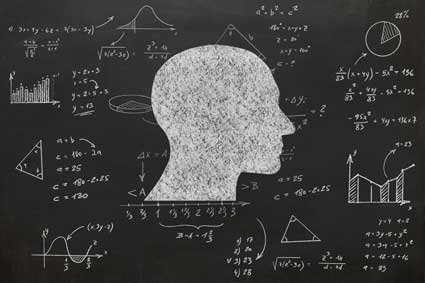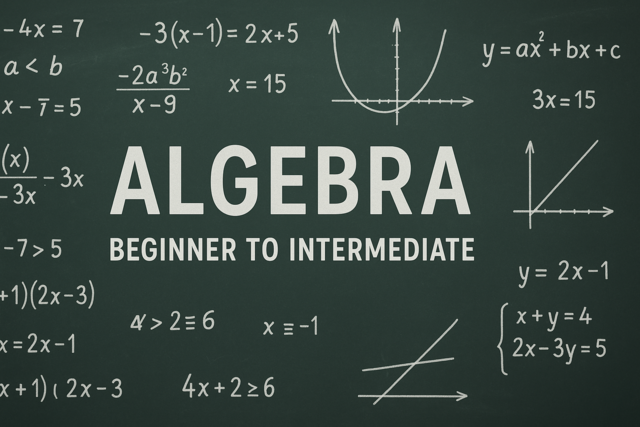E pluribus unum - or e unus pluribum, it could go either way...
When dealing with particle movement and behavior, we will now consider mass (along with time and distance) as something we wish to subdivide. Evidence has proven that chunks of matter are comprised of tiny pieces, which individually exhibit particle behavior.
When considering the motion of a particle (how its position or location is based on time), we are able to look at it one dimension at a time in an effort to forego a great deal of complicated mathematics.
If there are three equations of motion that help to specify the movement of a free particle in space, how many equations of motion do you think it would take to identify the motion of two particles? It would in fact require six equations in total, or three per particle.
A. Constraints and Degrees of Freedom
However, in attempting to identify the movement of a particle there is a short cut that can be applied. We use constraints, physical properties of a system that reduce the number of Degrees of Freedom a system possesses.
Degrees of freedom are the number of independent variables that are needed to identify the position (location) of an object. Each independent variable needs to have an equation of motion to identify the motion. In this sense, the application of appropriate constraints is able to immeasurably simplify the calculations required.
Take for example a two-atom lump of iron with a billion plus atoms. If we had to treat each atom without constraint, we would have to solve at least three billion plus equations of motion. It is a good thing, then, that under our set of conditions, iron is a solid.
As a whole, to determine the motion of the lump, we may apply a constraint that the distance between atoms is fixed. Should that indeed be the case, how many degrees of freedom would a lump of iron have?
To accurately answer this question, we need to determine the number of independent variables that are needed to specify its position. We believe it will be significantly less than three zillion, but can it really be only three, as was true for a single particle?
This is the point at which the beauty of the constraint comes into play.
In attempting to anticipate the future of the two-atom lump of iron, we need only concern ourselves with those parameters that may be different in the future than they were in the past. Because the distance between the atoms will remain constant, we can skip over the distance factor when attempting to specify changes in its position. Therefore, we are able to fully specify the motion by using a set of five numbers: the x, y, and z coordinates of one atom and the distance of the other atom from any pair of axes.
B. Two Types of Freedom
- Translational or Translation. One freedom involved the ability the atoms had to unify without changing their position relative to one another. This type of motion is referred to as Translational Motion or Translation.
In this form of motion, each point within a body experiences the same general sense of displacement to the degree where one particle's motion represents the motion of the entire body.
- Non-Translational. The other type of freedom involves the atoms ability to move freely in relation to one another without the entire body having to take part in the motion. This then is referred to as Non-Translational Motion.
C. Center of Mass
It is important to point out that even when an object rotates or vibrates while it moves, there is a point within the body, referred to as the Center of Mass that moves in a manner similar to how a single particle would move if exposed to the same external forces.
And there neither needs to be any particle at the Center of Mass, nor does the Center of Mass need to be inside of a solid object. An object supported at its center does not tip in any one way. For solid objects, its Center of Mass will be at the balance point.
The physical significance of the Center of Mass can be represented in an equation:
m*rcm = m1*r1 + m2*r2 ... + mn*rn
This equation is true now and it will always be true. In fact, you can find no instance in time when it will not be true.
Because of this, we know that the rate of change on the left side of the equation is equal to the rate of change on the right side. Bear in mind that "r" is the acceleration of an object located by the vector "r'", so the equation above says that the total mass times the acceleration of the Center of Mass is equal to the sum of each particle's mass times its acceleration.
Based upon Newton's second law, we know that the product of each particle's mass times its acceleration is the force exerting pressure upon that particle. Utilizing this knowledge, we can ascertain that the total mass of a group of particles times the acceleration of the Center of Mass is equal to the vector sum of all the forces exerting pressure upon the group of particles.
Therefore:
m*rcm = f1 + f2 ... + fn
Among all the forces acting on the particles will be the internal forces that the particles exert on one another. Newton's third law says that all these internal forces act in pairs, action and reaction; theoretically, then, they cancel each other out in the vector sum. The net effect on the right side of the equation above is the sum of the external or applied forces, fa.
That brings us to the relationship:
m*rcm = fa
In words, the Center of Mass of a system of particles moves as though all the mass was concentrated at that point and all the external forces were applied to that point.
As we were able to reach this understanding without even studying the specific nature of the system of particles, our result then applies to rigid objects in which the particles are at fixed distances from one another other, as well as, any collection of particles regardless of whether there is complicated internal motion relative to the Center of Mass.
Note: When dealing with systems of many particles, the Center of Mass allows us to interpret the motion of one particle as being representative of the entire system.
D. Out-of-the-Norm Dynamics
In quantum physics, which attempts to determine the behavior of ever-tinier particles, there is a tendency to focus on out-of-the norm systematic behaviors. Specifically, particle-based models, which were formerly part of collective interactive units, are presently exhibiting "estranged" behaviors, where, either on account of internal or external forces, they are being driven away from the equilibrium of the system.
In externally driven, multiparticle systems, there exists a continual sense of competition between the driving forces and the 'fizzling' friction forces. Ultimately, this leads to a spatio-temporal (relating to space and time) redistribution of energy, which in turn produces a wide range of cluster and grouping phenomena.
Due to non-linear formations in the equations of motion, small initial disturbances are enhanced while non-equilibrium patterns are stabilized. In fluids, this can lead to the creation of waves or vortices. In vibrated granular media, one tends to find the following:
- Emergent convection patterns (heated air rises to make way for cooler air which sinks).
- Collective oscillating states (changes in atmospheric conditions).
- Random segregation of granular materials and (or) self-organization according to valence sizes (emitting power).



























